MARIANO TOMATISWONDER INJECTORItalian writer and magician
|
 Magic & Scientific DiscoveriesThe man who (didn’t) walk across the river Seine Posted on wednesday 25 june 2014, 44 days before scifoo14 • Written by Mariano TomatisThe philosopher and magician Martin Gardner once wrote: Just as knowing how a magic trick is done spoils all its wonder, so let us be grateful that wherever Science and Reason turn they plunge finally into stygian darkness. (1) Since Science borders with Magic, exploring its boundaries may be extremely risky. Commenting on one of the most funny blunder of 18th century, Robert Darnton asked: Man had just conquered the air; why could he not walk on water? What limits could be set to the invisible powers at the command of his reason? (2) On 25 June 2011 the British magician Steven Frayne, best known for his TV appearnces on the show Dynamo: Mission Impossible, has been seen walking across the river Thames. Many have compared Dynamo’s stunt to Jesus’ miracle (Matthew 14:22-33; Mark 6:45-52; John 6:15-21) but not many know that an engraving dated 1783 shows a similar scene; set in Paris, it represents a man walking across the river Seine. 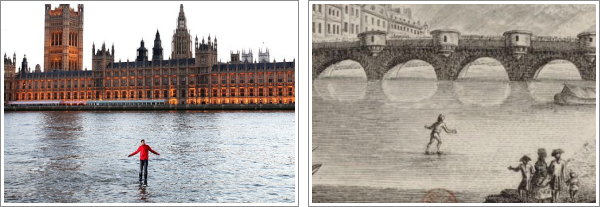 Left: Dynamo on Daily Mail (2011). Perhaps he is an ancestor of Dynamo, because he signs with the letter D. We know little about him. He is a watchmaker from Lyon, but we remember him for an amazing invention: the elastic shoes for walking on water. The idea came to him looking a mechanical little doll and throwing stones on the surface of a river. On 8 December 1783 he announced the discovery in the Journal de Paris (3).  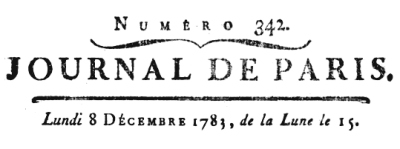 Lyon, December 1783. […] My discovery […] is the result of 20 years of work and expense. I’m flattered to have found the sure-fire way to walk with my feet dry on the surface of the water. I have discovered this looking at one of those mechanical rotating dolls that move thanks to a spring. Starting from the simplicity of this mechanism, I combined it with the principle that makes stones bouncing on the water of a river, concluding that it was possible to combine the two forces progressively, so that the resultant is able to support a weight more or less significant depending on its speed; with a motion proportional to the weight you can hold a solid object in equilibrium above a fluid. From these conjectures, I worked with the trust in the possibility of successfully implementing it, then achieving results which would not fail to arouse amazement and offer something revolutionary. I propose to traverse the length and breadth of the Seine without getting wet shoes, and to accomplish the feat multiple times on 1 January 1784 under the Pont-Neuf in Paris; but only if I will find on the other side, at the end of my journey, two hundred Louis with which to finance the trip. I am not going to exploit any other contraption except for a pair of elastic shoes, distant from one another no more than a normal step, fixed with a bar as two copper spheres. Each shoe, a foot long, will be 7 inches wide and high; with a pair of shoes like that, I can cross the wider river even 50 times in an hour. The curiosity and love for the arts and the public good will certainly encourage an adequate number of people in funding the amount of money requested, without which I can not perform the stunt. […] Signed: D…, watchmaker.  The Journal de Paris acts as guarantor for the collection of the money needed (200 Louis or the equivalent figure for 4800 livres) and in two days more than 1800 livres are collected. 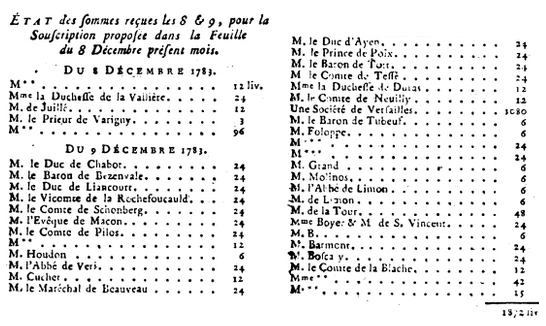 Subscription report from Journal de Paris, 11.12.1783, p. 1416. On December 13, money raise to 3243 livres and among donors there is also the famous Marquis de La Fayette, who pays 48 pounds (equal to 2 Luigi, 1% of the total). 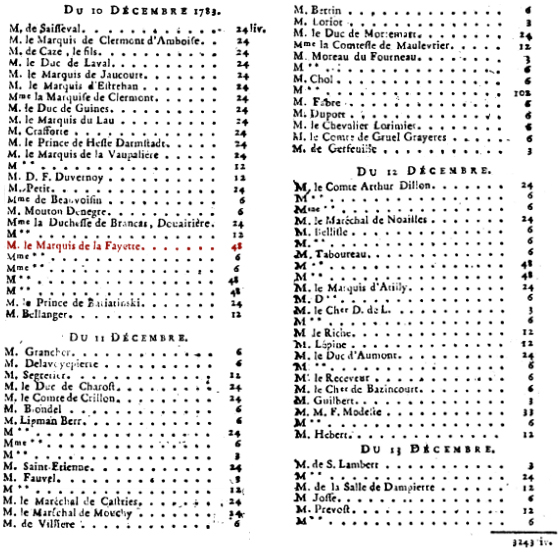 Subscription report from Journal de Paris, 11.12.1783, pp. 1436-1437. On December 18, the Journal involves the subscribers in the choice for the place from which they will watch “the spectacle of a man walking on the water” and explains that the tickets will be distributed to regulate access to the area. (4) In the meantime, P. Sellier is commissioned to create an artistic engraving of the event (5), to be offered to those who have subscribed. He imagines the scene like this: 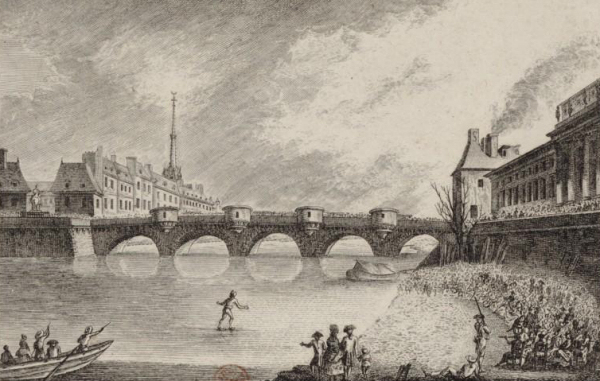 On 22 December, the daily journal takes a step back: Monsieur De Combles, the intermediary of the watchmaker, is increasingly vague and the correspondence with him becomes every day more suspicious; the existence of Mr. D. comes to doubt, and in a letter he declares that his name was Luc (but is he writing?). According to the Journal there is enough to stop the subscription: since it is most likely a hoax, who has paid the sums is asked to return to get it back. (6) Two days later, the paper confirms that it was a sham, adding that many readers have preferred to leave the money to charities. (7) But the imagination of the artists has already been tickled, and before discovering the hoax, circulating engravings herald the scene — imagining that the protagonist will support himself with two small balloons. 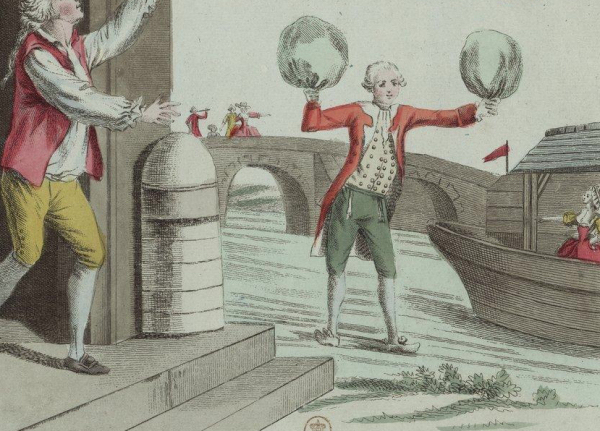 Even the Magasin Pittoresque dedicates to the event a portrait in action. (8)  Robert Darnton will comment: The burst of enthusiasm for the project, the imposing names on the list of subscribers, and the lack of precautions taken by the journal pointed to the same attitude. […] By February 7 [the journal] had overcome its embarassment well enough to print a letter promoting a technique for seeing in the dark, which was sponsored by a club of balloon enthusiasts convinced of the brotherhood of “nyctalopes, hydrophobes, somnambulists and water witchers.” (9)  _________________ (1) Martin Gardner, The Whys of a Philosophical Scrivener, St. Martin Griffin, New York 1999, p. 341. (2) Robert Darnton, Mesmerism and the End of the Enlightenment in France, Harvard University Press, 2009, pp. 23-24. (3) Journal de Paris, 8.12.1783, pp. 1404-1405. (4) Journal de Paris, 18.12.1783, p. 1448. (5) The engraving will be described as extremely rare in La Revue universelle des arts, t. IV, marzo 1857, pp. 544-547. (6) Journal de Paris, 22.12.1783, pp. 1465-1467. (7) Journal de Paris, 24.12.1783, pp. 1474-1475. (8) Magasin pittoresque, t. XIX, 1851, p. 273. (9) Robert Darnton, Mesmerism and the End of the Enlightenment in France, Harvard University Press, 2009, pp. 23-24. You could be interested also in:
|
 Science Foo Camp (or “Sci Foo”) is an invitation-only gathering organized by Digital Science, O'Reilly Media, and Google, with support from Nature. The 9th edition of Sci Foo takes place on 8-10 August 2014 at the Googleplex in Mountain View, CA. Lord Martin Rees has defined it as “a sort of mini Woodstock of the Mind”. Participants include researchers, writers, educators, artists, policy makers, investors, and other thought leaders, all doing groundbreaking work in diverse areas of science and technology.
Science Foo Camp (or “Sci Foo”) is an invitation-only gathering organized by Digital Science, O'Reilly Media, and Google, with support from Nature. The 9th edition of Sci Foo takes place on 8-10 August 2014 at the Googleplex in Mountain View, CA. Lord Martin Rees has defined it as “a sort of mini Woodstock of the Mind”. Participants include researchers, writers, educators, artists, policy makers, investors, and other thought leaders, all doing groundbreaking work in diverse areas of science and technology.